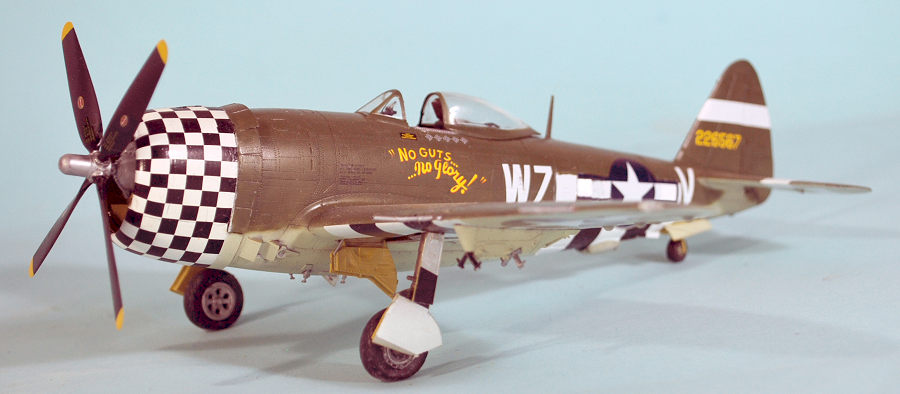
MiniArt 1/48 P-47D-25 Thunderbolt
| KIT #: | 48009 |
| PRICE: | $59.00 |
| DECALS: | Two Options |
| REVIEWER: | Tom Cleaver |
| NOTES: | Thundercals 48-006 |

| HISTORY |
78th Fighter Group ground crewman Warren Kellerstadt recalled: “They didn’t tell us when D-Day was going to be, but the night before we could smell something in the wind. They closed up the base tight and wouldn’t let anyone on or off and right after supper on June 5, they ordered black and white stripes painted around the wings and fuselages of the planes. We armorers were kept busy all night lugging bombs from the dump out to the dispersal area to stack next to the planes. I worked til midnight, then had guard from 0200 hours. All night long the bombers went out, first the RAF, then ours. They all had their navigation lights on because there were so many of them they had to worry about collisions, and the sky looked like a Christmas tree, full of red and green lights.”
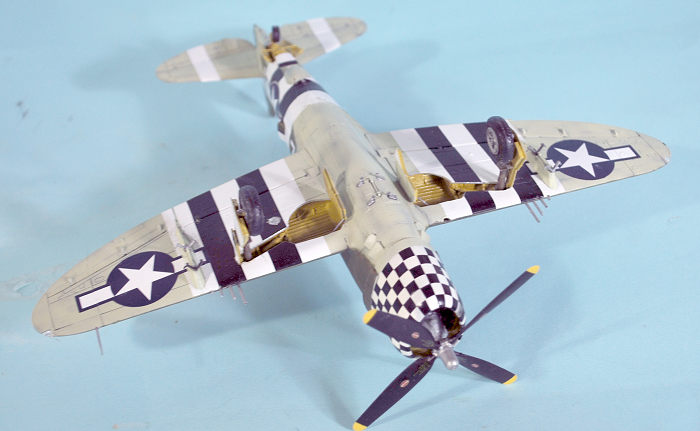 The
78th cranked engines at 0320 hours for the first D-Day mission. Rain was pouring
and visibility was so bad pilot Richard Holly remembered that when Colonel
Gray’s first section took off, “He just barely cleared the end of the runway
before he was out of sight.” When his flight lined up for magneto check Holly
instructed the other three pilots to set their gyros on his and follow him. “It
was the only instrument takeoff I made in the war and also the only one I made
with water injection all the way because we were so heavy.”
The
78th cranked engines at 0320 hours for the first D-Day mission. Rain was pouring
and visibility was so bad pilot Richard Holly remembered that when Colonel
Gray’s first section took off, “He just barely cleared the end of the runway
before he was out of sight.” When his flight lined up for magneto check Holly
instructed the other three pilots to set their gyros on his and follow him. “It
was the only instrument takeoff I made in the war and also the only one I made
with water injection all the way because we were so heavy.”
The 78th was heavily involved in air support for the invasion over the month of June, flying multiple missions almost every day in marginal weather. By month’s end, the group had flown 45 missions, during which they claimed 20 aerial victories, one ground victory, and thirteen locomotives, for a loss of 16 pilots killed and one evader, the heaviest monthly loss yet experienced. The 83rd Squadron flew 639 sorties with 14 aborts including eight failing to take off successfully with their heavy loads. They fired 78,000 rounds and dropped 79 tons of bombs; the pilots averaged 78 flying hours each, also a new record.
As losses mounted and new pilots arrived in the unit, some proved to be different from the veterans they replaced. Crew Chief James Tudor recalled, ‘Some young pilots coming into the unit gave us mechanics a fit. While flying your plane on a mission, they would get as far as the Channel when all of a sudden the engine would begin to act up, so back to base they came. The write-up in the Form One was familiar: “Engine runs excessively rough,” or “Prop surges at a given altitude.” Some of these guys we hated to draw once we got to know them, because you could predict an abort with a high degree of accuracy. Some overcame it after a few trips, others never did.’
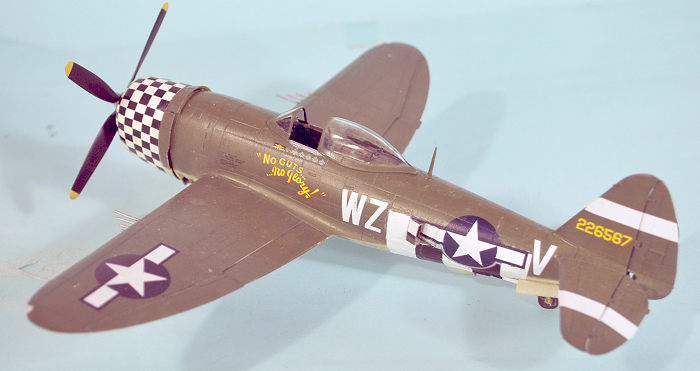 19
July saw both success and tragedy for the 78th. Major Ben Mayo, 84th Squadron
commander, led 78A group on the first deep-penetration escort mission since the
invasion. Weaving over the lead bombers, a German airfield full of airplanes was
spotted at Eutingen. Ten minutes later when their relief arrived, the
Thunderbolts went back to hit the field. Dropping low 20 miles out per standard
doctrine, they made a sweeping pass over the field, which was only lightly
protected by flak. Mayo - flying his new P-47D-25, which he had named “No Guts
No Glory” - saw the attack was successful and called for a second run which was
more successful: 11 pilots had blown up 17 Ju-188s, Do-217s, Ju-87s and Me-410s.
As they pulled away from the burning field, 82nd Squadron commander Major Doug
Munson, flying his fourth mission of his second tour, spotted another airfield
at Freudenstadt. Leading his squadron in an attack against Ju-52s, he destroyed
two. Again the defenses were light and Munson called for a second run. As Jim
Kinsolving remembered, “He got good hits on a second Ju-52, and then he appeared
to take a flak hit and nosed down. He struck at a slight angle and burst into
flame.” While both the 82nd and 83rd squadrons went through several commanders
due to combat losses, Mayo continued - seemingly indomitable - until he failed
to return from a dusk mission to Arnhem on 18 September in support of the
surrounded British paratroopers; whether it was flak or an enemy fighter popping
out of the clouds in the strange misty light, no one ever knew. Mayo was the
only loss.
19
July saw both success and tragedy for the 78th. Major Ben Mayo, 84th Squadron
commander, led 78A group on the first deep-penetration escort mission since the
invasion. Weaving over the lead bombers, a German airfield full of airplanes was
spotted at Eutingen. Ten minutes later when their relief arrived, the
Thunderbolts went back to hit the field. Dropping low 20 miles out per standard
doctrine, they made a sweeping pass over the field, which was only lightly
protected by flak. Mayo - flying his new P-47D-25, which he had named “No Guts
No Glory” - saw the attack was successful and called for a second run which was
more successful: 11 pilots had blown up 17 Ju-188s, Do-217s, Ju-87s and Me-410s.
As they pulled away from the burning field, 82nd Squadron commander Major Doug
Munson, flying his fourth mission of his second tour, spotted another airfield
at Freudenstadt. Leading his squadron in an attack against Ju-52s, he destroyed
two. Again the defenses were light and Munson called for a second run. As Jim
Kinsolving remembered, “He got good hits on a second Ju-52, and then he appeared
to take a flak hit and nosed down. He struck at a slight angle and burst into
flame.” While both the 82nd and 83rd squadrons went through several commanders
due to combat losses, Mayo continued - seemingly indomitable - until he failed
to return from a dusk mission to Arnhem on 18 September in support of the
surrounded British paratroopers; whether it was flak or an enemy fighter popping
out of the clouds in the strange misty light, no one ever knew. Mayo was the
only loss.
| THE KIT |
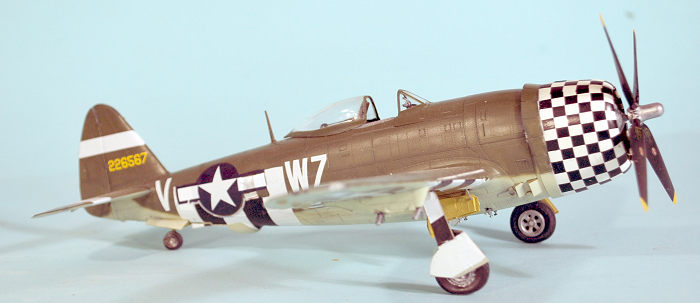 The
MiniArt P-47D-25RE was announced this past Spring and began drawing interest
when CAD drawings were released that showed they intended a kit far more
detailed than the Tamiya P-47s. There are two kits that have now been released,
the “Basic Kit” that is reviewed here, and an “advanced” kit that includes a
fully-detailed engine and accessories section and full gunbays and ammo
compartments in the wings. The kit has petite surface detail similar in quality
to the Eduard P-51D series of kits.
The
MiniArt P-47D-25RE was announced this past Spring and began drawing interest
when CAD drawings were released that showed they intended a kit far more
detailed than the Tamiya P-47s. There are two kits that have now been released,
the “Basic Kit” that is reviewed here, and an “advanced” kit that includes a
fully-detailed engine and accessories section and full gunbays and ammo
compartments in the wings. The kit has petite surface detail similar in quality
to the Eduard P-51D series of kits.
| CONSTRUCTION |
Like all other modern kits designed with CAD, parts fit is very precise, and a modeler must be certain all mating surfaces are “as clean as a hound’s tooth” to avoid cascading fit problems in construction. The kit is detailed with lots more pieces than the Tamiya kit has, and a modeler is well-advised to take the revolutionary act of reading and following the instructions; they are not “somebody’s opinion.”
Construction starts with the cockpit, which is much more detailed than the Tamiya kit. I painted the main parts with Tamiya Dark Green (RLM-70) a good replacement for Dull Dark Green, then painted all the other small parts before assembling them. I departed from a fully OOB build by using Eduard seatbelts. Once the cockpit was assembled, I installed it in the right fuselage half and proceeded to assemble the other detail parts for the fuselage, then glued the two halves together. Fit is so tight that all I had to do to lose the centerline seam was a light scrapedown, followed by rescribing rivet detail across the seam with my pounce wheel. The gear well in each wing is made up of individual pieces. I painted these with Mr. Color Yellow Zinc Chromate.
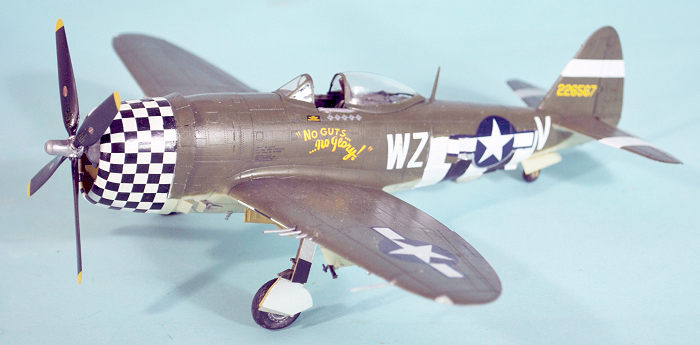 From
my experience with the first kit, I decided not to install the gun barrels at
this stage, but to attach them individually after construction, painting and
decaling was complete.
From
my experience with the first kit, I decided not to install the gun barrels at
this stage, but to attach them individually after construction, painting and
decaling was complete.
All the control surfaces are separate, and the flaps cannot be dropped; this is actually the proper way they should be. Several pilots in the 78th group who I interviewed for my books told me that the fine for not raising flaps immediately after touchdown was 10 Pounds - $70 out of a 2nd Lieutenant’s pay at the time of $250; as one said, “you only forgot once.”
The wings do not have carry-through spars like the Tamiya kit, but the extended spar on each side will help align them properly and the part design won’t allow a close fit without the wing being properly aligned. If you are going to have the underwing pylon and the rocket tubes, be sure to open the alignment holes before gluing the wing halves together.
The R-2800 engine in the kit is the best I have seen as an injection-molded plastic part. There is more detail in the engine and the assembly of the cowling than in any earlier kit. For this kit, one only uses the two piston rows and the front parts of the engine, leaving the very complete exhaust system on the sprue since that is for the “advanced” kit. I had no problem assembling the engine cowling accurately, following the kit instructions as to the sequence of attachment.
| COLORS & MARKINGS |
I decided to do Ben Mayo’s Thunderbolt “No Guts No Glory” from the 78th Group’s 84th Squadron, as seen in the summer of 1944 during the Battle of Normandy. I decided to use Tamiya’s D-Day stripe decals, as well as the ID stripe decals in the Thundercals sheet. Thus I only had to paint the cowling white and paint the overall camouflage.
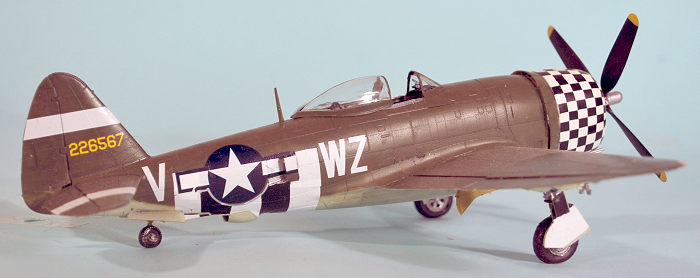 The
cowling was painted with Tamiya Gloss White X-2. I then masked that off and
preshaded the rest of the model along panel lines. The 78th Fighter Group used
RAF paints for camouflage, with the upper surface in RAF Dark Green and the
lower surface in RAF Sky. I used the Mr Color paints for these colors.
The
cowling was painted with Tamiya Gloss White X-2. I then masked that off and
preshaded the rest of the model along panel lines. The 78th Fighter Group used
RAF paints for camouflage, with the upper surface in RAF Dark Green and the
lower surface in RAF Sky. I used the Mr Color paints for these colors.
Fortunately, I had two decal sheets from the Tamiya Bubbletop kit, which greatly helped when doing the D-Day stripes. The Tamiya decals are thick, but after repeated attacks with Solvaset, they melted down into the surface detail perfectly. I also applied the ID stripes on the vertical fin and horizontal stabilizers. I used Fundekals 45" US National insignia for the lower wings, and the Thundercals national insignia for the rest. The Thundercals personal and individual aircraft markings went on without trouble. These airplanes did not have stenciling after the camouflage was applied. After the decals set up overnight, I gave the model an overall coat of Micro “Satin” clear varnish. Photos of Mayo’s P-47 show it well maintained so I didn’t ding it.
I attached the landing gear and the underwing pylons and the prop. I unmasked the canopy and posed it in the open position.
| CONCLUSIONS |
The MiniArt P-47 is the best P-47 kit available in any scale. I know I will be doing more, since the new P-47D-30 release arrived the day I finished this model. If you take care to follow the instructions and take your time to get assembly right, you won’t use any filler and you’ll have a really nice model of the P-47, whatever markings you put it in. Highly recommended to any experienced modeler.
Thanks again to MiniArt for this second review kit.
15 February 2024
Copyright ModelingMadness.com. All rights reserved. No
reproduction in part or in whole without express permission.
If you would like your product reviewed fairly and fairly
quickly, please
contact
the editor
or see other details in the
Note to
Contributors.